Preprint
Data Descriptor
Multi-Year Datasets of Groundwater Level and Surface Water Budget in a Central Mediterranean Site
This version is not peer-reviewed.
Submitted:
09 January 2023
Posted:
10 January 2023
You are already at the latest version
A peer-reviewed article of this preprint also exists.
Abstract
This note makes available five years of data gathered in a measurement site equipped with a micrometeorological station and two monitoring wells. Series of data of hydrological and atmospheric variables allow to estimate the flux of water across the atmosphere-land interface and to calculate the water budget, that are crucial topics in climate and environmental sciences. The measures of water-table began during 2017, one of the driest year of the whole instrumental period of climate history for the Central Mediterranean. Data from the micrometeorological station have been used to construct two more datasets of daily and monthly cumulative values of different terms of the surface water budget, from which the groundwater infiltration has been estimated. A significant decreasing trend characterizes both the data time series of piezometric heights and estimated infiltration in the considered period. All the data are collected in 2017-2022 datasets that are available in the supplementary material.
Keywords:
Subject:
Environmental and Earth Sciences - Atmospheric Science and Meteorologysupplementary.zip (42.89KB )
1. Summary
Datasets including groundwater level, soil moisture, and meteorological parameters allow to estimate fluxes of water and energy across the atmosphere-land interface and to calculate water budgets [1,2,3,4,5]. Given their fundamental importance in climate and environmental sciences, series of data of hydrological and atmospheric parameters taken at specific sites are becoming increasingly freely shared [6,7,8].
Several regions in the world, including the Euro-Mediterranean, were affected by declining groundwater resources in the last decades [9,10]. Drought events linked to increases of temperature, in combination with decreasing of precipitation in the summer months, has been indicated among the main causes [11,12]. From July 2016 to June 2017 western-central Europe was affected by the most severe meteorological drought at the continental scale since at least 1979 [13]. Winter 2016/17 was drier than normal on the Central Mediterranean, with precipitation totals reached only 60% of normal precipitation [14]. In 2017, Italy experienced the driest year of the whole instrumental period of its climate history [15].
Since June 2017, the Institute of Atmospheric Sciences and Climate of the National Research Council of Italy (ISAC-CNR) takes measures of water-table depth of a shallow karst aquifer (the Miocene Aquifer of Central-Eastern Salento, hereinafter referred as MACES) located in the Salento Peninsula (Apulia region, Italy). The measures are taken from two wells located few hundreds of meters from the ISAC-CNR Micrometeorological Station (IMS) in operation since June 2002 [16,17,18]. As a whole, wells and station constitute a measurement site that allows direct comparison between hydrological and weather data. Due to their climate sensitivity and subsurface heterogeneity, the karst systems located in dry lands require particular attention in processing data related to the exchanges among air, soil and groundwater [19,20]. Series of data from this site have been used to interpret the local water consumption during the lockdown for COVID-19 [21]. Datasets of IMS were previously used to calculate recharge time and specific yield of the regional deep aquifer [22,23]. This note provides and makes available five hydrological years (from 1 October to 30 September in the Northern Hemisphere) of gathered data with the aim of promoting open science and fostering cooperation by making related description and insights shareable.
2. Data Descriptor
2.1. Physical Setting
Located in the Central Mediterranean, the Salento Peninsula constitutes a lowland plateau (maximum altitude 200 m) surrounded by the Ionian Sea to the West and South and by the Adriatic Sea to the East. Precipitations are usually limited (about 700 mm/y of mean annual precipitation) due to the low orography and the residual blocking effect of the Apennine Chain (150 kn NW of Salento), for the incoming cyclonic moisture flux coming from the Atlantic Ocean, generally accompanied by southern winds. Moderate northern winds typically blow during daytime in high pressure conditions, with clear skies and strong insolation. The warm/dry season (April–September) is characterized by temperatures that can reach 40 °C and more, and reduced precipitations, while the cold/wet season (October-March) by mild autumn–winter temperatures (generally above zero even at night) and enhanced precipitations. In recent years, there has been a generalized tendency to an increase in more intense, brief precipitation events during the spring-summer months [22].
Groundwater resources of the Salento Peninsula are contained in a complex system of aquifers, consisting of a main regional reservoir, the Cretaceous Aquifer (CA), and several shallow aquifers [24,25,26]. Among these latter, MACES is the most important in terms of stored groundwater volume. It is supplied by meteoric water and two Plio-Quaternary aquifers, and extensively exploited for irrigation and domestic purposes through several licensed and unlicensed wells. In the warm/dry season, MACES is recharged by irrigation water withdrawn from the CA (more hydrogeological features are given in Appendix A).
2.2. Measurement Site and Equipment
The measurement site is placed in a suburban area 5 km south-west from Lecce (Figure A1), within the Ecotekne Campus of the University of Salento, with mixed local vegetation like Mediterranean shrubs, pines and olive groves, scattered buildings, and quarried surfaces (Figure 1). Here, the water table of MACES lies at a depth of 20-22 m below the ground [21].
The IMS [16,17] has been a data provider for the Hymex (Hydrological Mediterranean Experiment) project long term campaign [27]. It is mainly devoted to water and energy surface-atmosphere transfer, and is composed by two complementary systems collecting data based on half-hour averages: 1) a 16 m height mast equipped with a fast response eddy correlation system and basic meteorological data; 2) a meteorological station that collects also standard meteorological and soil surface data in a dedicated data logger. The mast has a typical flux footprint fetch of the order of hundreds of meters [22,28], thus taking contributions from the campus and some immediately surrounding vegetated areas. Both data files from the two systems are stored in local memory and then transferred to the web data base once per day through UMTS connection system [18]. Details of the instrumentation for the considered period of measurements are the following.
2.2.1. Telescopic mast (top level 14 m above surface)
The Eddy covariance system (measurements of turbulence, heat and evapotranspiration fluxes) is composed by one Solent-Gill 20 Hz ultrasonic anemometer and one Campbell Kh20 Krypton hygrometer. One thermohygrometer for standard air temperature and humidity measurements (Rotronic MP100). Data are firstly collected in a dedicated notebook that calculates the half hour eddy covariance statistics rotated in the ‘streamline’ coordinate system [29] before storage in the daily data file.
2.2.2. Meteorological station
It is equipped with standard meteorological sensors and soil data sensors (data are collected by a dedicated Campbel CR1000-X datalogger).
Standard sensors (2 meters height):
Cup anemometer (Campbell A100R) , windvane (Campbell W200P) thermohygrometer (Rotronic MP100), four-components net radiometer (Hukseflux NR01), precipitation gauge (EM ARG100), barometer (pressure sensor Campbell PTB101B).
Soil sensors:
2 thermistor temperature sensors (Campbell109L, 2 and 5 cm depth), 2 thermopile soil heat flux sensor (Hukseflux HFP01, 2 and 5 cm depth), 2 moisture content capacitive sensors (Decagon EC-5, 2 and 35 cm depth)
2.3. Groundwater Level Measures
The two monitoring wells of the measurement site (named Fiorini, FW, and Benessere, BW, Figure 1) were hand dug about 25 m deep decades ago, to provide water for agriculture and rural settlements. The wells are easily identifiable by their stone well heads (Figure A3, Figure A4). The measurements of the phreatic level began in June 2017 for FW, and in June 2018 for BW. They have been taken using a portable electronic water-table meter (Boviar GST-FR100), with an average frequency of one measure every about three days for both wells (more frequently in conjunction with some rainy events; for more details see see Appendix B). Despite the laboriousness of the field operations, the use a water-table meter allow to overcome problems related to the lack of funding for research and the reliability of the measurements in case of equipment malfunction [31,32,33]. Embedded in well hydrographs there is valuable information on aquifer responses to both natural and human stresses [34].
2.4. Data Records
The dataset of the water-table depths taken from June 2017 to October 2022 is supplied as text file in Supplementary Materials (Table S1). The columns represent the following items:
- date (gg/mm/yy)
- water-table depth measured in FW (m)
- water-table depth measured in BW (m).
There are only few gaps in the dataset, because sometimes adverse weather conditions prevented the measure for one of the two wells. The curves of the variations of the groundwater head in the monitored wells are shown in Figure 2.
For FW, the measure of the water-table depth started in the middle of the warm/dry season (June 2017) of the 2016-2017 hydrological year. A year later (June 2018), monitoring of BW began. Note that the two lines fit almost perfectly. Only in very few cases, the daily variations in FW and BW were of the opposite sign (Table S1). A general negative trend from the hydrological year 2017-2018 to 2021-2022 is apparent. At the end of the 2021-2022 hydrological year (June-September 2022), the groundwater level in FW was nearly coincident with that of June-September 2017.
The datasets of surface water budget are available in the Supplementary Materials (Tables S2, S3) as text files of daily/monthly data. The columns represent the following items:
- date (Julian day or fraction of year representing the end of each month)
- precipitation (daily/monthly cumulative, m)
- real evapotranspiration (daily/monthly cumulative, m)
- soil moisture 2 cm (beginning of the day/month, m3/m3)
- soil moisture 2 cm (end of the day/month, m3/m3)
- soil moisture 35 cm (beginning of the day/month, m3/m3)
- soil moisture 35 cm (end of the day/month, m3/m3)
- estimated infiltration (daily/monthly cumulative, m)
- percentage of validated data (daily/monthly cumulative)
- corrected real evapotranspiration (daily/monthly cumulative corrected by percentage of lacking data, m)
- corrected estimated infiltration (daily/monthly cumulative corrected by percentage of lacking data, m).
The corrected estimated monthly infiltration values for the MACES are shown in Figure 3, where still possible negative values have been set to zero to properly represent the groundwater contribution (see also Section 3). Other data are plotted in Figure A6, Figure A7 (Appendix C).
3. Methods
To collect the water-table depth, reference points were fixed on the stone casing of each monitored well. A rod was placed on the well head to reference the depth read by the water-table meter (Appendix B, Figure A3, Figure A5). In this way it was possible to measure the depth with an accuracy of 0.5 cm. Furthermore, this system allowed the use of several operators without affecting the reliability of the data.
For the soil water balance, in order to estimate the net infiltration, the following mass conservation equation is considered [22,35,36]:
where S(t) is the soil water content per unit area, and P, E, I, R and Ir are the total precipitation, actual evapotranspiration, net infiltration, surface-subsurface runoff, and irrigation water in the time interval dt, respectively. Due to the hydrological features of the measurement site and its surroundings, the runoff term R has been neglected. In fact, the site is placed on a large sub-horizontal ground without any appreciable slope, thus neither stream systems nor persistent pond waters are present.
To quantify the surface water transfer data from the IMS the following data have been used:
1) cumulative precipitation P;
2) averaged evapotranspiration flux;
3) averaged soil moisture at 2 cm (s1) and 35 cm (s2) depth.
All data are taken on a 30 minutes base interval (averages, and cumulative for precipitation). The averaged evapotranspiration flux has then been transformed in 30-minutes cumulative evapotranspiration E.
After calculating the total monthly cumulative values for the above quantities the monthly net infiltration I has been calculated by the following expression between the initial (t) and final (t+dt) time of each day/month [22]:
In equation (2) the Ir term has been neglected (as well as R). The anthropic irrigation is indeed absent in the measurement area but still present over the whole MACES region and will be the object of further studies. In equation (2) P and E are directly derived by the measurements, while S(t) has been calculated approximating an average soil moisture content per square meter as:
where s1 and s2 are the available soil moisture density measurements (in m3/m3 at 2 cm and 35 cm underground respectively) and h represents an effective soil thickness estimated as 0.4 m approximately [22]. Negative values of I (eq. 2) are still possible in very dry conditions because of the approximations in equation (3) but they are to be considered as vanishing contributes to the MACES water balance (see also [22]). In the daily/monthly averaging of the evapotranspiration, where it is more likely to have some missing data, the actual percentage of the available data has been also calculated, resulting generally over 80%. The results have then been corrected adding to the cumulative value the product of the lacking data percentage times the calculated daily/monthly average, to approximately compensate the effect of the missing data. The estimated infiltration for MACES is shown in Figure 3 with the related linear trend. A more complete data view can be found in the Supplementary Materials (Tables S2, S3).
4. User Notes
The trend of the water-table fluctuations (Figure 2) apparently suggest a decline of the groundwater resource and is in agreement with the negative trend in the estimated infiltration for the considered five hydrological years (Figure 3). The infiltration decrease is associated to a decrease in precipitation in the considered five years, while the real evapotranspiration shows a less significant negative trend in the same period (see also Appendix C). Thus, the reduced surface water input affects the MACES groundwater input. This finding gives an insight about the natural stress that affected MACES from 2017 to 2022. However, no data are available about the anthropogenic stress [21]. Moreover, the recharge by irrigation water (Ir) withdrawn from the CA during the warm/dry season is unknown. This currently prevents the calculation of the actual aquifer water budget. The measurements in the site herein shown and the sharing of the updated datasets are scheduled to continue for some more years.
Supplementary Materials
The following supporting information can be downloaded at the website of this paper posted on Preprints.org, Table S1: Water-table depth; Table S2: Daily IMS data; Table S3: Monthly IMS data.
Author Contributions
Conceptualization, methodology, investigation, data curation, writing and editing, M.D.R. and P.M.
Funding
This research received no external funding.
Institutional Review Board Statement
Not applicable.
Informed Consent Statement
Not applicable.
Data Availability Statement
All the datasets mentioned in this article are available in the supplementary material as text files. Original raw data (30 minutes averages) from the IMS micrometeorological station are freely available upon request to p.martano@isac.cnr.it.
Acknowledgments
The authors thank Luca Ciricugno (ISAC-CNR) for her technical support in the water-table measurement and Fabio Grasso (ISAC-CNR) and Cosimo Elefante (University of Salento) for their contributions to the management of the micrometeorological station data archive.
Conflicts of Interest
The author declare no conflict of interest.
Appendix A. Hydrogeological Framework
The hydrogeological framework of the Salento Peninsula is characterized by two superimposed water bodies: the regional deep CA (permeable by fracturing and karst) and a series of local shallow aquifers (permeable by porosity, fracturing and karst) [24,25,26]. The former is constituted by limestone and dolostone, the latter by porous calcarenite and partially lithified sand, all cracked by tectonic stress and affected by karst dissolution (with various degrees of impact in the hydraulic properties). The shallow MACES is located at the eastern Salento, where constitutes the main water resource. The measurement site is close to the western boundary of MACES (Figure A1).
Figure A1.
Geological map of the central-eastern Salento. 1. Plio-Quaternay units; 2. Miocene and Oligocene units; 3. Cretaceous units; 4. boundary of Miocene Aquifer of Central-Eastern Salento (MACES); 5. boundary of Plio-Quaternary aquifers; (after [21], modified).
Figure A1.
Geological map of the central-eastern Salento. 1. Plio-Quaternay units; 2. Miocene and Oligocene units; 3. Cretaceous units; 4. boundary of Miocene Aquifer of Central-Eastern Salento (MACES); 5. boundary of Plio-Quaternary aquifers; (after [21], modified).
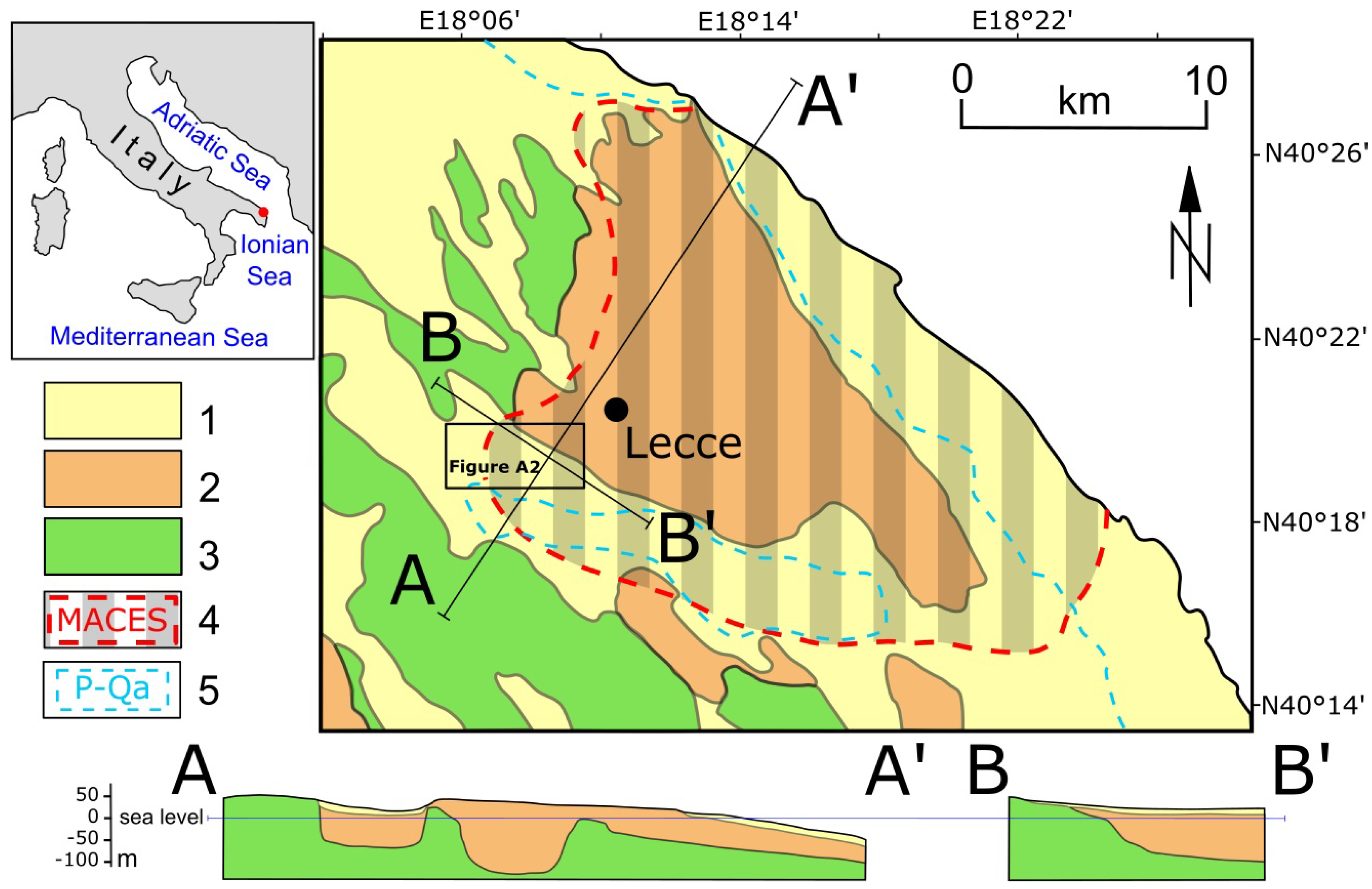
In the area of the measurement site, an aquiclude constituted by Tertiary very low-permeability rocks [21], is interposed between MACES and CA. As a local result, the first is unconfined while the second is here a confined water body (whose groundwater is under pressure greater than atmospheric). About the hydraulic relationship among MACES and CA, the well EI 61/II (see Figure A2 for its location) drilled and equipped in the mid-1950s by the regional agency for irrigation (Ente Irrigazione, EI) is of reference. Under static condition (no exploitation of groundwater), the aquifers showed the same water-table level (2.8 m a.s.l.) [21]. Such a result was confirmed by a survey performed in the mid-1980s [37], the last hydrogeological study carried out in this area.
Again with reference to the measurement site, MACES is supplied by water coming from a Plio-Quaternary aquifer that is superimposed to it at the southern boundary (Figure A1). The water exchanges between these aquifers are unknown but they should not significantly affect the water-table depths [37].
Figure A2.
Contour map of the groundwater levels in the study area (m a.s.l.); solid light-blue line, Miocene Aquifer of Central-Eastern Salento (MACES); red dashed line, MACES boundary; solid blue line, regional Cretaceous Aquifer (CA); IMS, ISAC-CNR Micrometeorological Station; FW, Fiorini well; BW, Benessere well; EI 61/II, Ente Irrigazione well (after [21,37], modified).
Figure A2.
Contour map of the groundwater levels in the study area (m a.s.l.); solid light-blue line, Miocene Aquifer of Central-Eastern Salento (MACES); red dashed line, MACES boundary; solid blue line, regional Cretaceous Aquifer (CA); IMS, ISAC-CNR Micrometeorological Station; FW, Fiorini well; BW, Benessere well; EI 61/II, Ente Irrigazione well (after [21,37], modified).
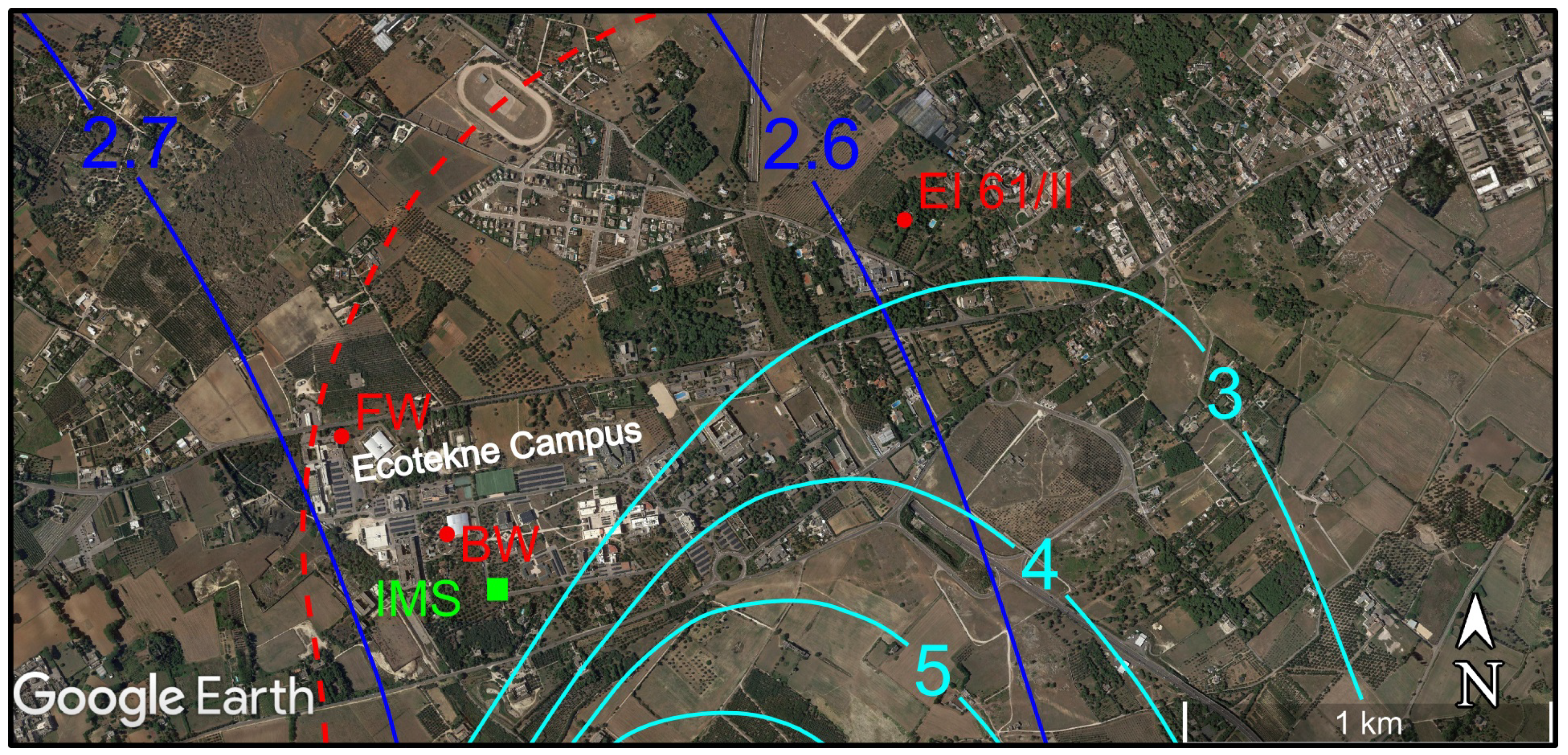
CA is in hydrodynamic equilibrium with intruding marine waters, thus its water-table depth is determined by the Dupuit-Ghyben-Herzberg equation [38]. As such, it is affected by salinization processes [25,39]. In the area of the measurement site, the water-table depth of CA is the groundwater base-level for MACES. Northwestward the measurement site, the aquiclude gradually loses the property to confine the aquifers for the reduced thickness and a variation in hydraulic properties of the Tertiary rocks, thus the water of MACES drains into CA (cf. Figure A2).
Appendix B. Data sheet of the monitoring wells
Well heads of FW and BW are cased by stone walls, circular in shape below the ground, and square in shape above the surface. The water-table measures are taken by placing a 2 cm thick rod between two opposite sides of the stone casing (Figure A3, Figure A4).
Figure A3.
A measure of water-table depth in the Fiorini Well (note the rod placed between the opposite side of the stone wall to have a fixed reference point). Photo by Marco Delle Rose.
Figure A3.
A measure of water-table depth in the Fiorini Well (note the rod placed between the opposite side of the stone wall to have a fixed reference point). Photo by Marco Delle Rose.
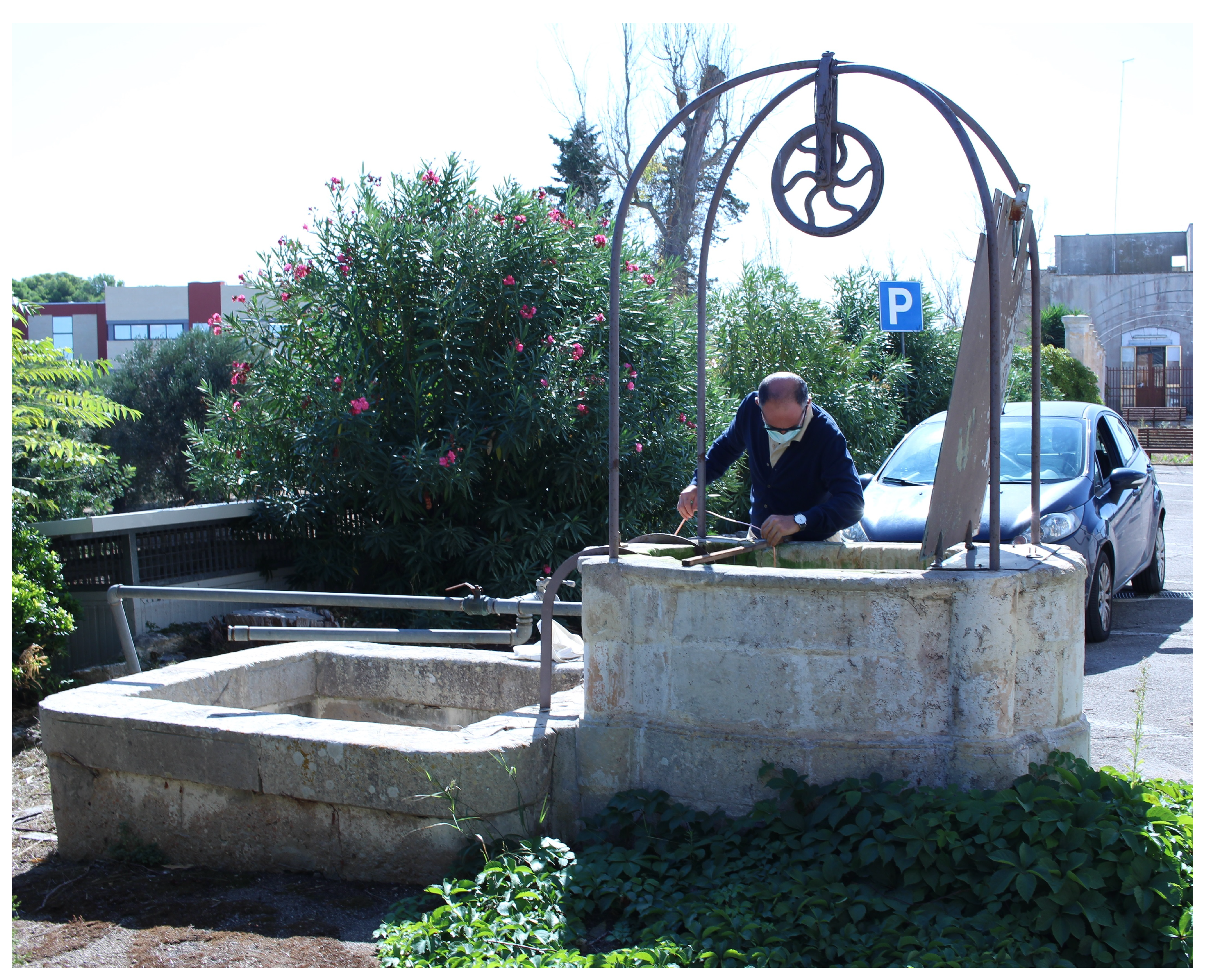
Figure A4.
The descent of the electronic meter in the Benessere Well. Photo by Luca Ciricugno.
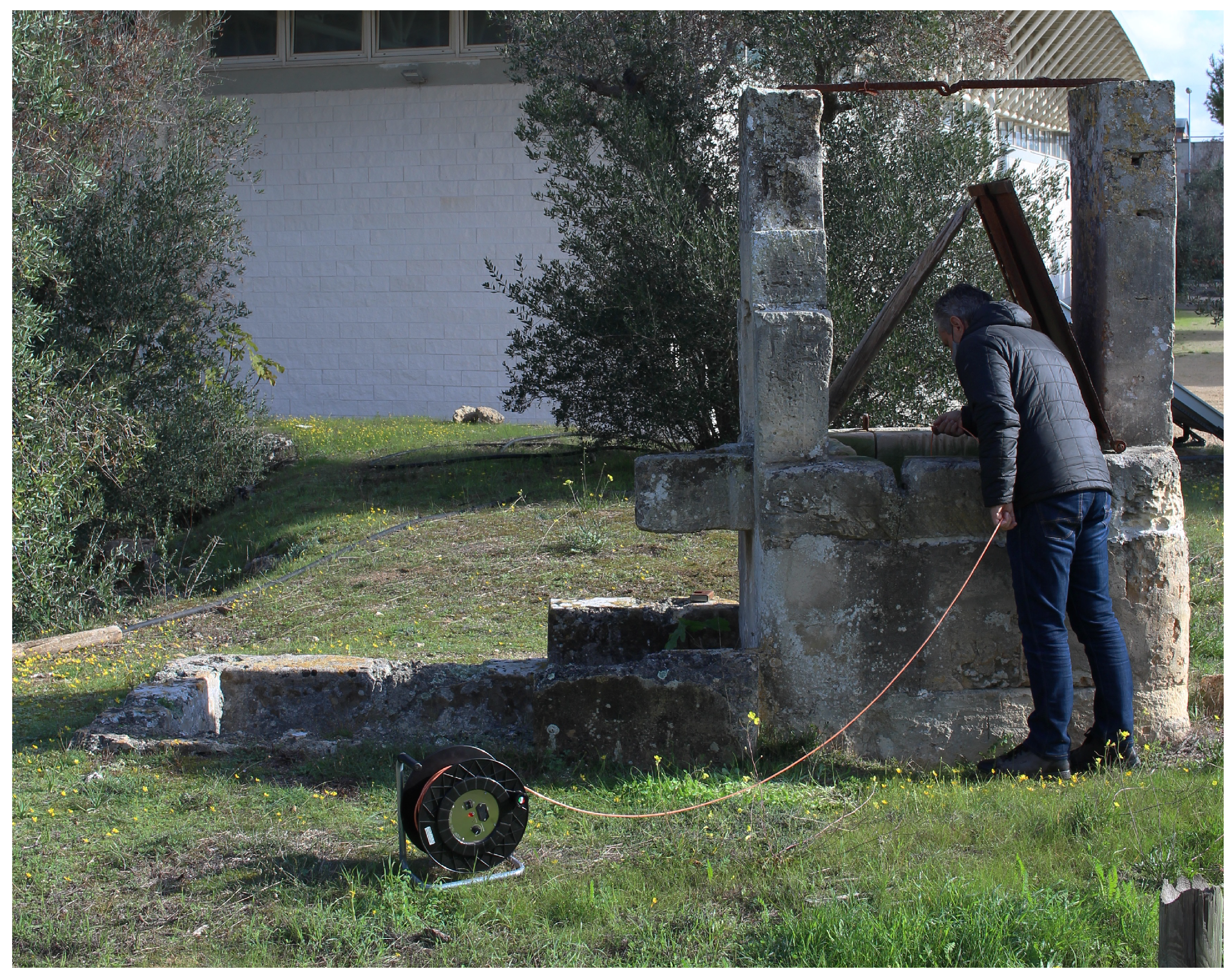
Based on the the provincial technical map at a scale of 1:5000, the height of the well head is 22.5 for FW and 24.7 m a.s.l. for BW (more accurate altitude data can be obtained by topographic leveling). Google Earth geographic coordinates are: 40°20’11.93" N, 18°06’43.09" E, for FW; 40°20’03.50" N, 18°06’55.30" E, for BW. The measurement scheme is shown in Figure A5.
Figure A5.
Scheme for the measurement of the water-table depth.
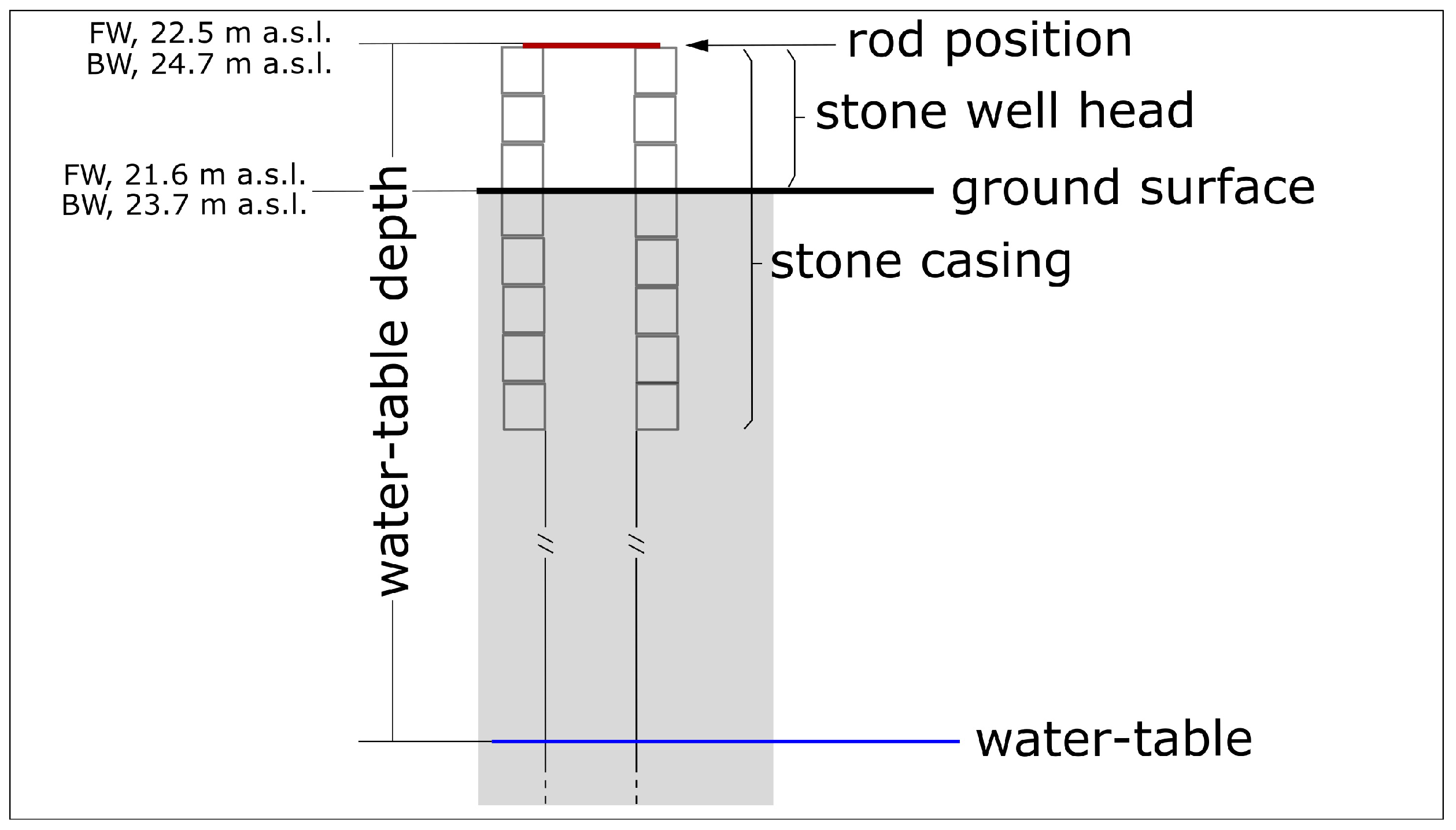
Appendix C. Monthly Precipitation, Evapotranspiration and Soil Moisture.
Figure A6 shows a bar plot of the monthly cumulative precipitation and evapotranspiration, as reported in the dataset. The clear decrease in precipitation in the last years does not correspond to a comparable decrease in the evapotranspiration.
Figure A6.
Bar plot of the cumulative monthly precipitation (red) and evapotranspiration (blue) in meters.
Figure A6.
Bar plot of the cumulative monthly precipitation (red) and evapotranspiration (blue) in meters.
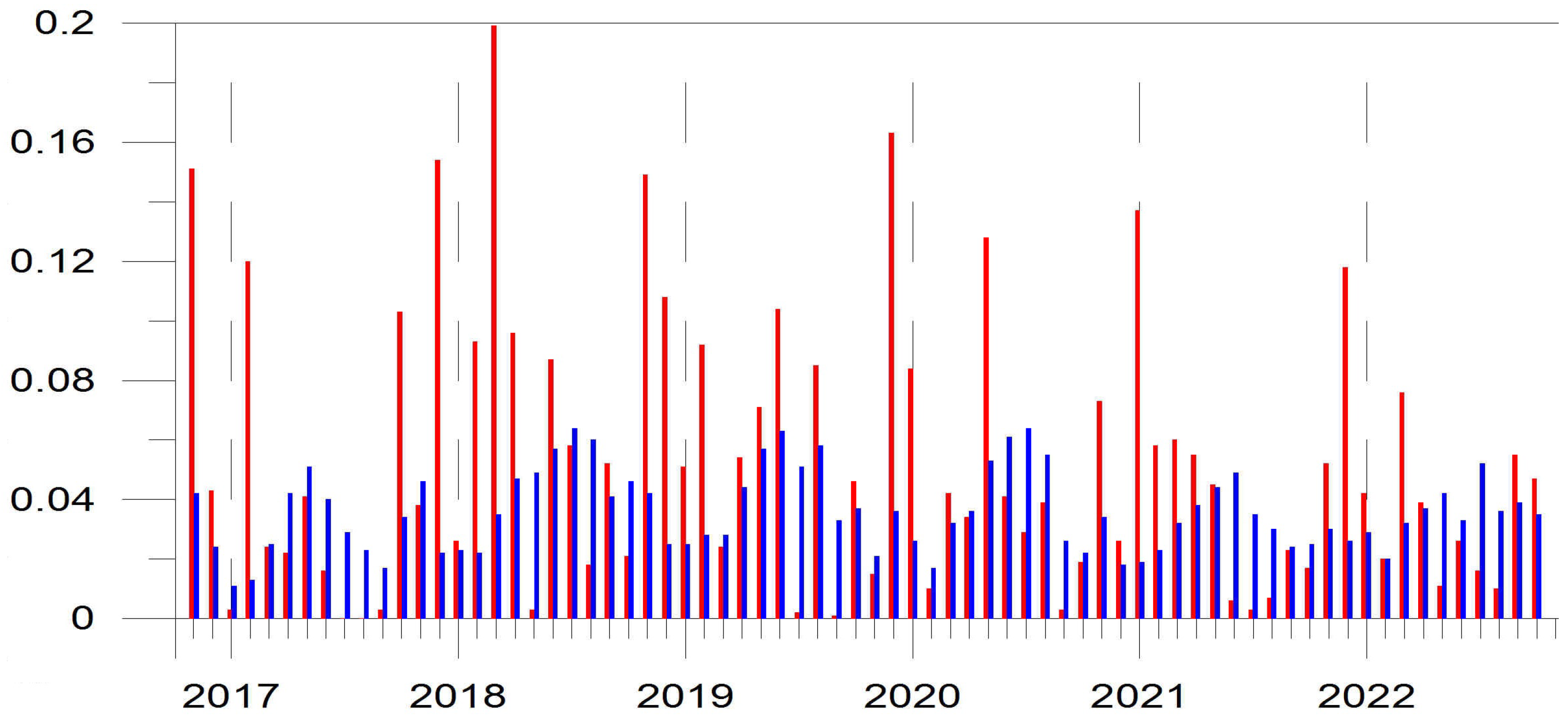
Figure A7 shows the soil moisture at two levels (end of month data) as reported in the dataset. Note the almost total loss of water in the surface level in summer months compared with the retaining of water in the bulk soil data. The accumulated/lost water amount in the soil moisture profile between the beginning and the end of each period and its uncertainty affect the estimated infiltration.
Figure A7.
Plot of the soil moisture at 2 cm (red circles) and 35 cm depth (black squares), in m3/m3 (monthly final data). The dashed lines are intended to help view only.
Figure A7.
Plot of the soil moisture at 2 cm (red circles) and 35 cm depth (black squares), in m3/m3 (monthly final data). The dashed lines are intended to help view only.
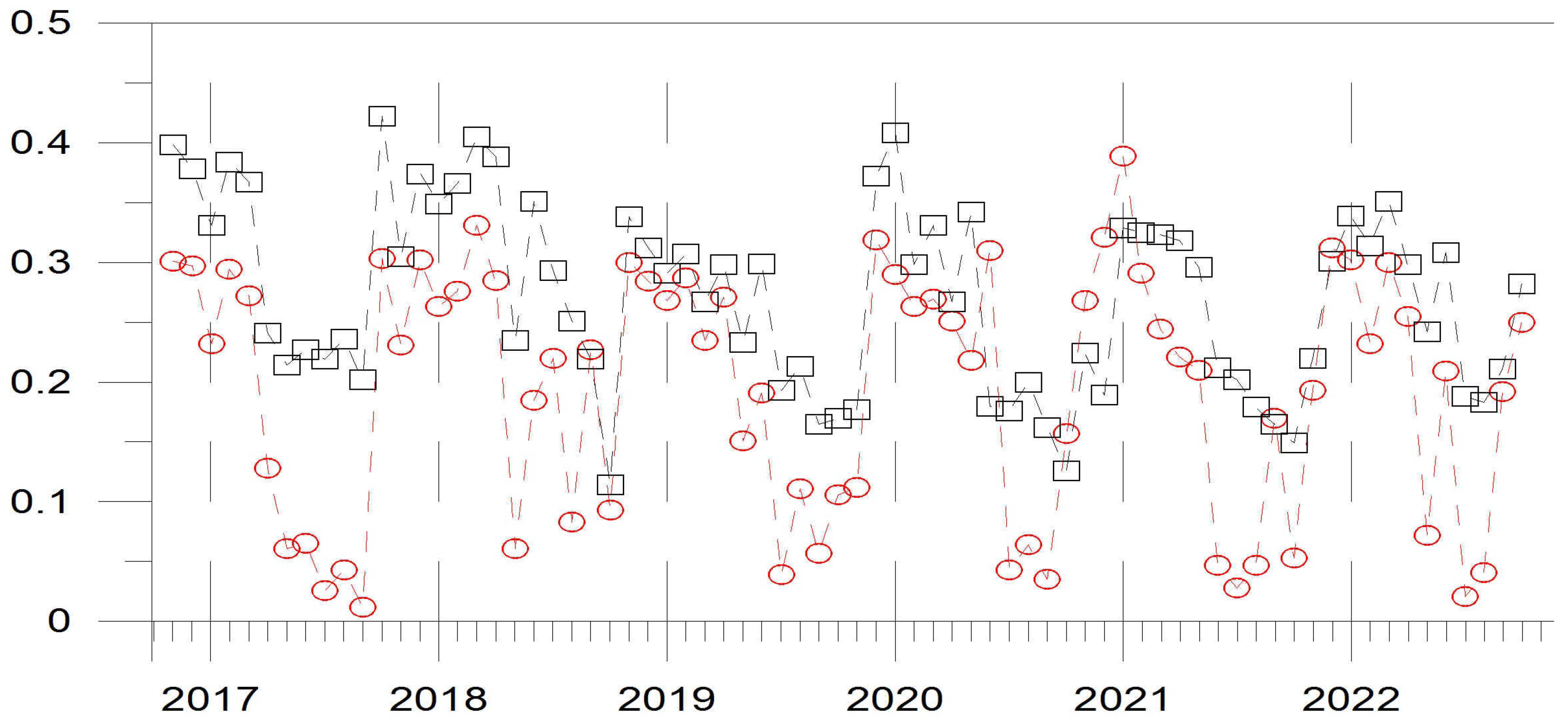
References
- Van Lanen, H.A.J.; Peters, E. Definition, Effects and Assessment of Groundwater Droughts. In Drought and drought mitigation in Europe; Vogt, J.V., Somma, F., Eds.; Springer: Dordrecht, The Netherlands, 2000; Volume 14, pp. 49–61. [Google Scholar]
- Reghunath, R.; Murthy, T.R.S.; Raghavan, B.R. Time Series Analysis to Monitor and Assess Water Resources: A Moving Average Approach. Environ. Monit. Assess. 2005, 109, 65–72. [Google Scholar] [CrossRef] [PubMed]
- Van der Velde, Y.; de Rooij, G.H.; Torfs, P.J.J.F. Catchment-scale non-linear groundwater-surface water interactions in densely drained lowland catchments. Hydrol. Earth Syst. Sci. 2009, 13, 1867–1885. [Google Scholar] [CrossRef]
- Cerlini, P.; Meniconi, S.; Brunone, B. Groundwater Supply and Climate Change Management by Means of Global Atmospheric Datasets. Preliminary Results. Procedia Eng. 2017, 186C, 420–427. [Google Scholar] [CrossRef]
- Varadharajan, C.; Agarwal, D.A.; Brown, W.; Burrus, M.; Carroll, R.W.H.; Christianson, D.S.; Dafflon, B.; Dwivedi, D.; Enquist, B.J.; Faybishenko, B.; Henderson, A.; Henderson, H.; Hendrix, V.C.; Hubbard, S. S; Kakalia, Z.; Newman, A.; Potter, B.; Steltzer, H.; Versteeg, R.; Williams, K.H.; Wilmer, C.; Wu, Y. Challenges in Building an End-to-End System for Acquisition, Management, and Integration of Diverse Data From Sensor Networks in Watersheds: Lessons From a Mountainous Community Observatory in East River, Colorado. IEEE Access 2019, 7, 182796–182813. [Google Scholar]
- Zabala, M.E.; Sanchez-Murillo, R.; Dietrich, S.; Gorocito, M.; Vives, L.; Manzano, M.; Varni, M. Hydrological dataset of a sub-humid continental plain basin (Buenos Aires, Argentina). Data Br. 2020, 33, 106400. [Google Scholar] [CrossRef]
- Nordio, G.; Fagherazzi, S. Groundwater, soil moisture, light and weather data collected in a coastal forest bordering a salt marsh in the Delmarva Peninsula (VA). Data Br. 2022, 45, 108584. [Google Scholar] [CrossRef] [PubMed]
- Taufik, M.; Marliana, T.W.; Awaluddin, A.; Mukharomah, A.K.; Minasny, B. Groundwater table and soil-hydrological properties datasets of Indonesian peatlands. Data Br. 2022, 41, 107903. [Google Scholar] [CrossRef]
- Lancia, M.; Petitta, M.; Zheng, C.; Saroli, M. Hydrogeological insights and modelling for sustainable use of a stressed carbonate aquifer in the Mediterranean area: From passive withdrawals to active management. J. Hydrol.: Reg. Stud. 2020, 32, 100749. [Google Scholar] [CrossRef]
- Xanke, J.; Liesch, T. Quantification and possible causes of declining groundwater resources in the Euro-Mediterranean region from 2003 to 2020. Hydrogeol. J. 2022, 30, 379–400. [Google Scholar] [CrossRef]
- Hanel, M.; Rakovec, O.; Markonis, Y.; Maca, P.; Samaniego, L. et Alii. Revisiting the recent European droughts from a long-term perspective. Sci. Rep. 2018, 8, 9499. [Google Scholar] [CrossRef] [PubMed]
- Moravec, V.; Markonis, Y.; Rakovec, O.; Svoboda, M.; Trnka, M. et Alii. Europe under multi-year droughts: how severe was the 2014–2018 drought period? Environ. Res. Lett. 2021, 16, 034062. [Google Scholar] [CrossRef]
- Garcia-Herrera, R.; Garrido-Perez, J.M.; Barriopedro, D.; Ordonez, C.; Vicente-Serrano, S.M.; et al. The European 2016/17 Drought. J. Climate 2019, 32, 3169–3187. [Google Scholar] [CrossRef]
- Bissolli, P.; Demircan, M.; Kennedy, J.J.; Lakatos, M.; McCarthy, M. et alii. Europe and the Middle East. In State of the Climate in 2017. Special Supplement of the Bull. Amer. Meteor. Soc.; Blunden, J., Arndt, D.S., Hartfield, G., Eds.; American Meteorological Society: Boston, Massachusetts, US, 2018; pp. 222–232. [Google Scholar]
- 2017 dryest Year in Italy for 200 Years. Available online: https://www.ansa.it/english/news/science_tecnology/2017/12/04/2017-dryest-year-in-italy-for-200-years-4_79d13a9e-d0fc-461f-a0c4-36ee4fa33cdb.html (accessed on 10 November 2022).
- Martano, P.; Elefante, C.; Grasso, F. A Database for long-term atmosphere-surface transfer monitoring in Salento peninsula (Southern Italy). Dataset Pap. Sci. 2013, 2013, 946431. [Google Scholar] [CrossRef]
- Martano, P.; Elefante, C.; Grasso, F. Ten years water and energy surface balance from the CNR-ISAC micrometeorological station in Salento peninsula (Southern Italy). Adv. Sci. Res. 2015, 12, 121–125. [Google Scholar] [CrossRef]
- ISAC-CNR. Micrometeorological Station. Available online: http://www.basesperimentale.le.isac.cnr.it.
- Hartmann, A.; Gleeson, T.; Wada, Y.; Wagener, T. Enhanced groundwater recharge rates and altered recharge sensitivity to climate variability through subsurface heterogeneity. PNAS 2017, 114, 2842–2847. [Google Scholar] [CrossRef] [PubMed]
- Berthelin, R.; Rinderer, M.; Andreo, B.; Baker, A.; Kilian, D.; Leonhardt, G.; Lotz, A.; Lichtenwoehrer, K.; Mudarra, M.; Padilla, I.Y.; Pantoja Agreda, F.; Rosolem, R.; Vale, A.; Hartmann, A. A soil moisture monitoring network to characterize karstic recharge and evapotranspiration at five representative sites across the globe. Geosci. Instrum. Method. Data Syst. 2020, 9, 11–23. [Google Scholar] [CrossRef]
- Alfio, M.R.; Balacco, G.; Delle Rose, M.; Fidelibus, C.; Martano, P. A Hydrometeorological Study of Groundwater Level Changes during the COVID-19 Lockdown Year (Salento Peninsula, Italy). Sustainability 2022, 14, 1710. [Google Scholar] [CrossRef]
- Delle Rose, M.; Martano, P. Infiltration and Short-Time Recharge in Deep Karst Aquifer of the Salento Peninsula (Southern Italy): An Observational Study. Water 2018, 10, 260. [Google Scholar] [CrossRef]
- Delle Rose, M.; Fidelibus, C.; Martano, P. Assessment of Specific Yield in Karstified Fractured Rock through the Water-Budget Method. Geosciences 2018, 8, 344. [Google Scholar] [CrossRef]
- Tadolini, T.; Tazioli, G.S.; Tulipano, L. Hydrogeology of the Idume springs area (Lecce). Geol. Appl. Idrogeol. 1971, 4, 41–63. (in Italian). [Google Scholar]
- Tadolini, T.; Tulipano, L. The evolution of fresh-water/salt-water equilibrium in connection with withd rawals from the coastal carbonate and carstic aquifer of the Salentine Peninsula (Southern Italy). Geol. Jaharb. 1981, 29, 69–85. [Google Scholar]
- Delle Rose, M. Sedimentological features of the Plio-Quaternary aquifers of Salento (Puglia). In Memorie Descrittive della Carta Geologica d’Italia, Vol. 76; Istituto Superiore per la Protezione e la Ricerca Ambientale: Rome, Italy, 2007; pp. 137–145. [Google Scholar]
- HyMeX in brief. Available online: www.hymex.org (accessed on Day Month Year).
- Hsieh, C.I.; Katul, G. , Chi, T. An approximate analytical model for footprint estimation of scalar fluxes in thermally stratified atmospheric flows. Adv. Water Resour. 2000, 23, 765–772. [Google Scholar] [CrossRef]
- McMillen, R. An eddy correlation Technique with extended applicability to non-simple terrain. Boundary-Layer Meteorol. 1988, 43, 231–245. [Google Scholar] [CrossRef]
- HyMeX database. Available online: www.hymex.org/database/ (accessed on Day Month Year).
- Korus, J. Combining Hydraulic Head Analysis with Airborne Electromagnetics to Detect and Map Impermeable Aquifer Boundaries. Water 2018, 10, 975. [Google Scholar] [CrossRef]
- Gorgoglione, A.; Castro, A.; Chreties, C.; Etcheverry, L. Overcoming Data Scarcity in Earth Science. Data 2020, 5, 5. [Google Scholar] [CrossRef]
- Rochford, L.M.; Ordens, C.M.; Bulovic, N.; McIntyre, N. Voluntary metering of rural groundwater extractions: understanding and resolving the challenges. Hydrogeol J. 2022, 30, 2251–2266. [Google Scholar] [CrossRef]
- Butler, J.J.; Knobbe, S.; Reboulet, E.C.; Whittemore, D.O.; Wilson, B.B.; Bohling, G.C. Water Well Hydrographs: An Underutilized Resource for Characterizing Subsurface Conditions. Groundwater 2021, 59, 808–818. [Google Scholar] [CrossRef] [PubMed]
- Portoghese, I.; Uricchio, V.; Vurro, M. A GIS tool for hydrogeological water balance evaluation on a regional scale in semi-arid environments. Comput. Geosci. 2005, 31, 15–27. [Google Scholar] [CrossRef]
- Gomez, D.G.; Ochoa, C.G.; Godwin, D.; Tomasek, A.A.; Zamora Re, M.I. Soil Water Balance and Shallow Aquifer Recharge in an Irrigated Pasture Field with Clay Soils in the Willamette Valley, Oregon, USA. Hydrology 2022, 9, 60. [Google Scholar] [CrossRef]
- Tadolini, T.; Calo, G.; Spizzico, M.; Tinelli, R. Hydrogeological characterisation of post-cretaceous soils in the San Cesario di Lecce area (Puglia). In Proceedings of the V Congresso Internazionale sulle Acque Sotterranee, Taormina, Italy, 17–21 November 1985; p. 11. (In Italian). [Google Scholar]
- Vacher, H.L. Dupuit-Ghyben-Herzberg analysis of strip-island lenses. GSA Bulletin 1988, 100, 580–591. [Google Scholar] [CrossRef]
- Delle Rose, M; Federico, A.; Fidelibus, C. A computer simulation of groundwater salinization risk in Salento peninsula (Italy). In Proceedings of Risk Analysis II - Second International Conference on Computer Simulation in Risk Analysis and Hazard Mitigation (WIT Press; Brebbia, C.A., Ed.); Bologna, Italy, 11-13 October 2000; pp. 465-475.
Figure 1.
Map of the measurement site (topography from Lecce Province Technical Map at a scale of 1:5000). IMS, ISAC-CNR Micrometeorological Station; FW, Fiorini Well; BW, Benessere Well. Ekotecne Campus in gray.
Figure 1.
Map of the measurement site (topography from Lecce Province Technical Map at a scale of 1:5000). IMS, ISAC-CNR Micrometeorological Station; FW, Fiorini Well; BW, Benessere Well. Ekotecne Campus in gray.
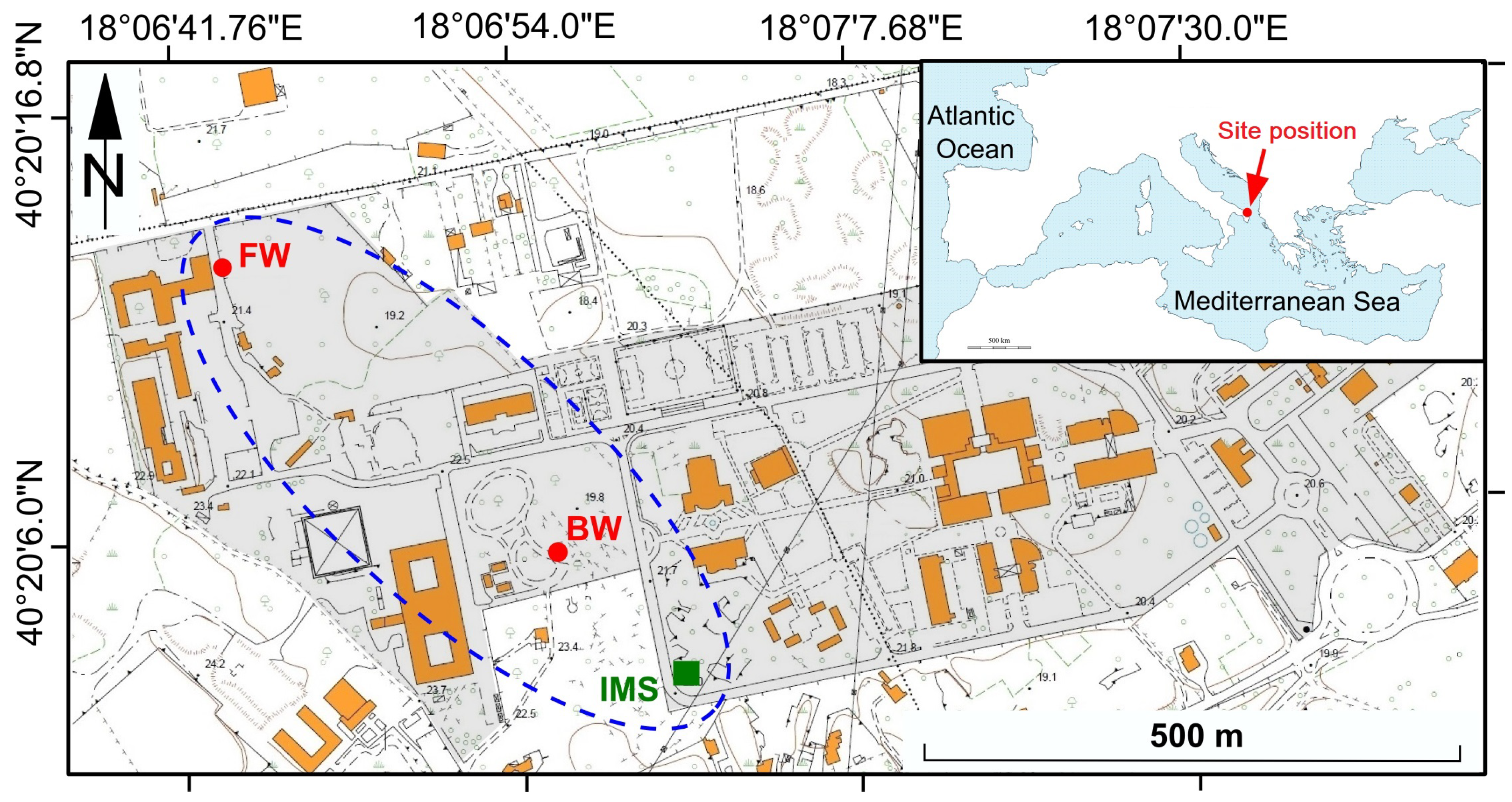
Figure 2.
Smoothed well hydrographs with linear regression (water-table depth in m below the well head; see Appendix B, Figure A5). Hydrological years are delimited.
Figure 2.
Smoothed well hydrographs with linear regression (water-table depth in m below the well head; see Appendix B, Figure A5). Hydrological years are delimited.
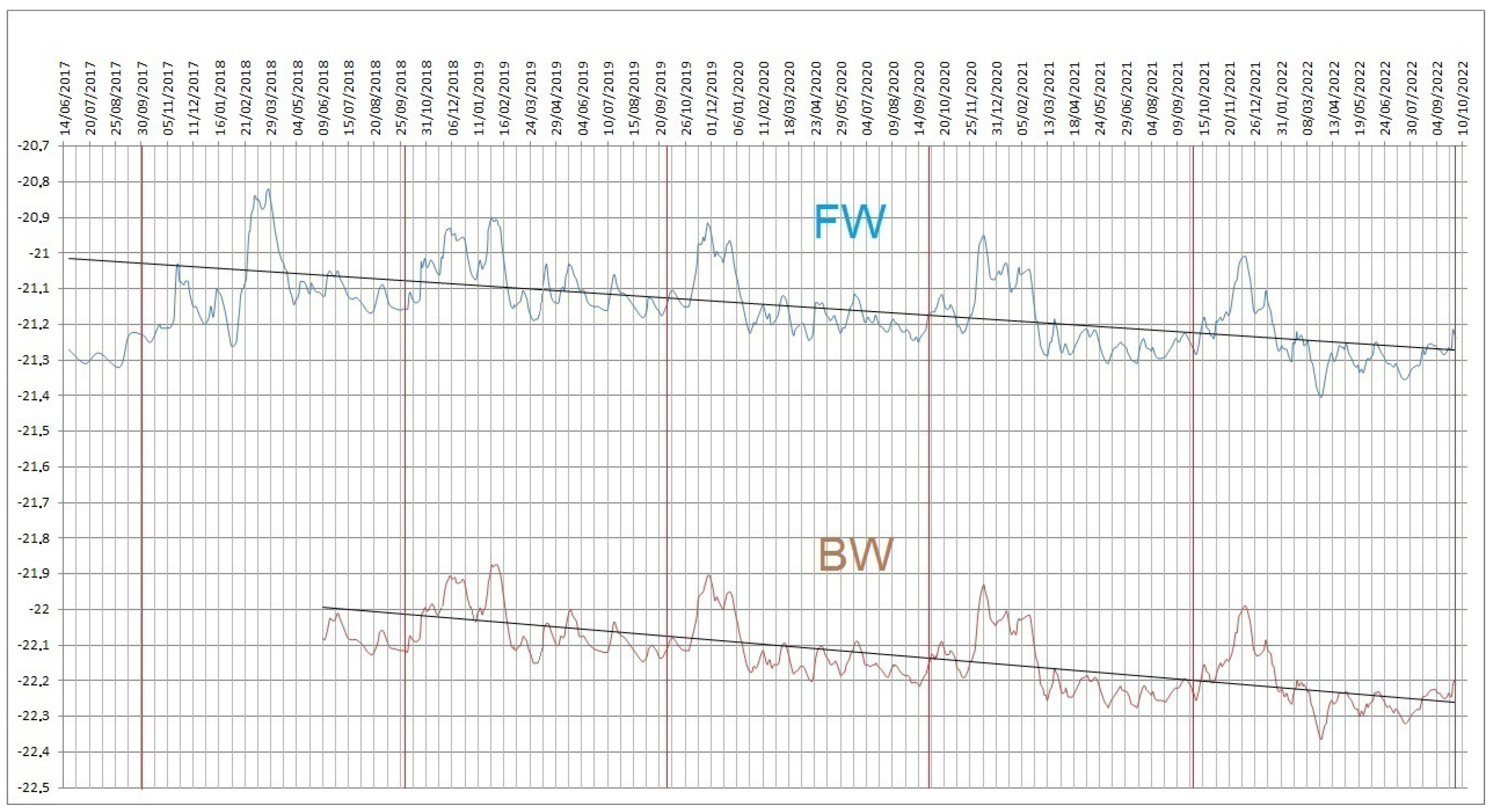
Figure 3.
Estimated monthly groundwater infiltration in meters with linear regression. In the upper side, the considered hydrological year are delimited.
Figure 3.
Estimated monthly groundwater infiltration in meters with linear regression. In the upper side, the considered hydrological year are delimited.
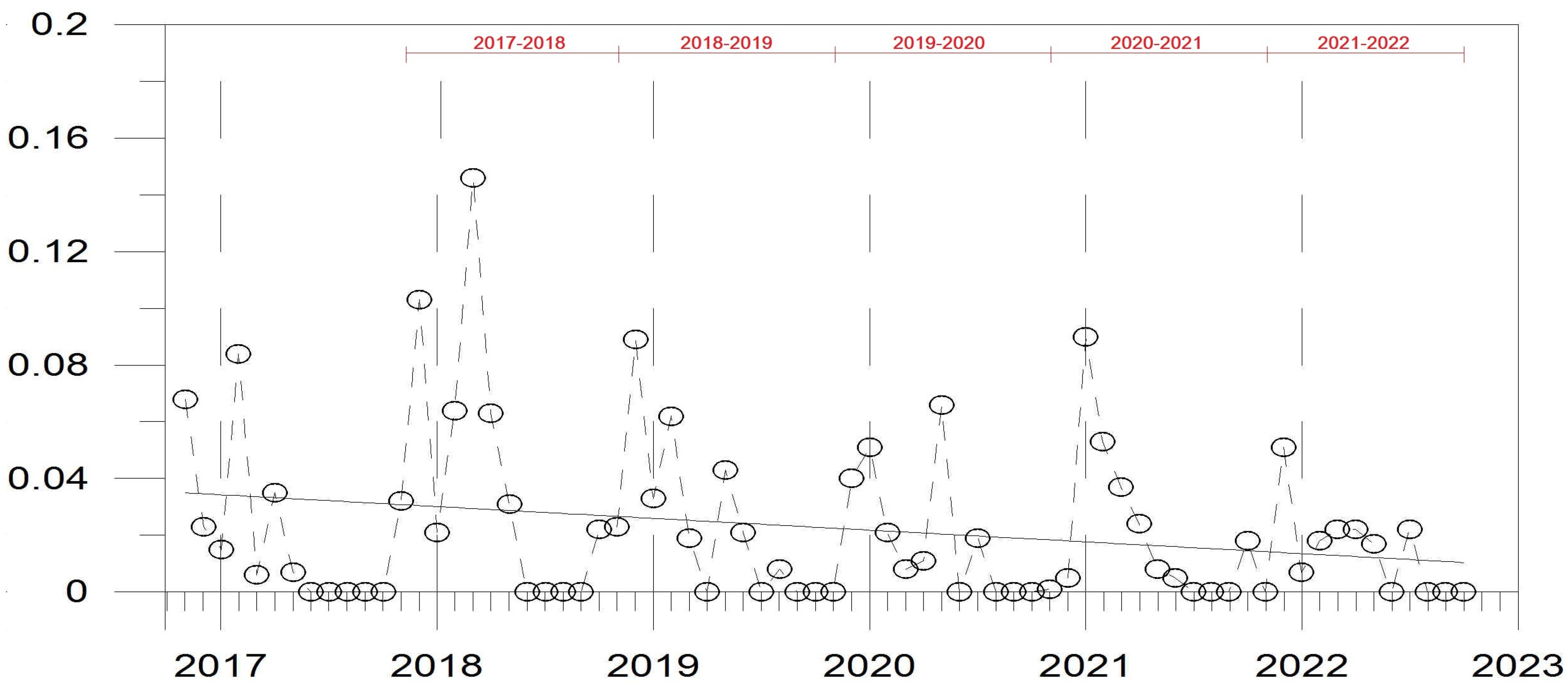
Disclaimer/Publisher’s Note: The statements, opinions and data contained in all publications are solely those of the individual author(s) and contributor(s) and not of MDPI and/or the editor(s). MDPI and/or the editor(s) disclaim responsibility for any injury to people or property resulting from any ideas, methods, instructions or products referred to in the content. |
© 2022 by the authors. Licensee MDPI, Basel, Switzerland. This article is an open access article distributed under the terms and conditions of the Creative Commons Attribution (CC BY) license (https://creativecommons.org/licenses/by/4.0/).
Copyright: This open access article is published under a Creative Commons CC BY 4.0 license, which permit the free download, distribution, and reuse, provided that the author and preprint are cited in any reuse.
Alerts
MDPI Initiatives
Important Links
© 2025 MDPI (Basel, Switzerland) unless otherwise stated






